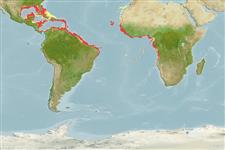Environment: milieu / climate zone / depth range / distribution range
Ekologi
laut berasosiasi dengan karang; kisaran kedalaman ? - 650 m (Ref. 3686), usually 50 - 300 m (Ref. 26999). Subtropical; 30°N - 14°S, 98°W - 15°E (Ref. 34024)
Western Atlantic: off the continental coast from Florida, USA and the Gulf of Mexico to northern South America, including islands in the Caribbean. Eastern Atlantic: off Senegal to Angola.
Size / Weight / umur
Maturity: Lm ? range ? - ? cm
Max length : 94.0 cm TL jantan/; (Ref. 40637); common length : 50.0 cm TL jantan/; (Ref. 5217); Berat maksimum terpublikasi: 8.5 kg (Ref. 40637)
Duri punggung (Keseluruhan (total)): 0; duri punggung lunak (Keseluruhan (total)): 109-117; Duri dubur 0; Sirip dubur lunak: 86 - 90. Body completely covered with small, imbricate, cycloid scales; barbels present on snout (6) and chin (6); branchiostegal rays 8; median basibranchial tooth patch absent; developed gill rakers on first arch 4 or fewer; pelvic fin rays inserted at about level of preopercle, well behind eye (Ref. 34024). Ventral fins dark, gradually becoming darker at the extreme blackish edge (Ref. 13608).
Common species (Ref. 34024). Adults benthopelagic (Ref. 34024) down to 650 m, but most often on the continental shelf (Ref. 3686), on sandy and muddy bottoms (Ref. 2683). Juveniles common in reefs (Ref. 34024). Smaller silvery specimens taken far out at sea in the epipelagic (Ref. 34024). Oviparous, with oval pelagic eggs floating in a gelatinous mass (Ref. 205).
Nielsen, J.G., D.M. Cohen, D.F. Markle and C.R. Robins, 1999. Ophidiiform fishes of the world (Order Ophidiiformes). An annotated and illustrated catalogue of pearlfishes, cusk-eels, brotulas and other ophidiiform fishes known to date. FAO Fish. Synop. 125(18):178p. Rome: FAO. (Ref. 34024)
Status IUCN Red List (Ref. 130435)
ancaman kepada manusia
Harmless
penggunaan manusia
Perikanan: nilai komersial kecil; Ikan buruan: ya
informasi lanjut
AcuanBudidaya airprofil budidaya airStrainGenetikaElectrophoresesDiturunkanPenyakit-penyakitPengolahanNutrientsMass conversion
Alat, peralatan
laporan khas
muat turun XML
Sumber internet
Estimates based on models
Preferred temperature (Ref.
123201): 12.5 - 26.5, mean 19.7 °C (based on 331 cells).
Phylogenetic diversity index (Ref.
82804): PD
50 = 0.5156 [Uniqueness, from 0.5 = low to 2.0 = high].
Bayesian length-weight: a=0.00372 (0.00180 - 0.00768), b=3.15 (2.96 - 3.34), in cm total length, based on LWR estimates for this species & (Sub)family-body (Ref.
93245).
Trophic level (Ref.
69278): 3.9 ±0.6 se; based on size and trophs of closest relatives
Generation time: 5.9 ( na - na) years. Estimated as median ln(3)/K based on 1
growth studies.
Daya lenting (Ref.
120179): sedang, Waktu penggandaan populasi minimum 1.4 - 4.4 tahun (K=0.19).
Fishing Vulnerability (Ref.
59153): Moderate to high vulnerability (52 of 100).
Climate Vulnerability (Ref.
125649): High vulnerability (65 of 100).
Nutrients (Ref.
124155): Calcium = 16.9 [8.3, 42.6] mg/100g; Iron = 0.451 [0.245, 0.908] mg/100g; Protein = 17.8 [15.3, 20.4] %; Omega3 = 0.183 [0.095, 0.343] g/100g; Selenium = 36.5 [17.0, 76.8] μg/100g; VitaminA = 28.2 [8.7, 94.9] μg/100g; Zinc = 0.568 [0.373, 0.874] mg/100g (wet weight);
